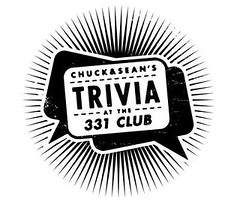 In all fairness, we had a perfectly reasonable excuse. We had decided the best way to get to know the boozy public access television show host was to go out drinking with him, and we spent the greater part of the evening hopping from one bar to another in Northeast Minneapolis. When we woke the next morning, the scant notes we had taken from the previous night were soaked in a sticky mixture of amaretto and Peychaud's Bitters, and flecked with vomit (a drink I like to call the Siamese Pick Me Up). Ordinarily, this would not be an issue, as, like Truman Capote, we have trained our brains to retain hours of conversation at a time. Unfortunately, we were just beginning the process of training our livers to hold a gallon of rum. Just as you cannot easily be a rich man and a moral man, you cannot be a drunkard and a mnemonicist.
In all fairness, we had a perfectly reasonable excuse. We had decided the best way to get to know the boozy public access television show host was to go out drinking with him, and we spent the greater part of the evening hopping from one bar to another in Northeast Minneapolis. When we woke the next morning, the scant notes we had taken from the previous night were soaked in a sticky mixture of amaretto and Peychaud's Bitters, and flecked with vomit (a drink I like to call the Siamese Pick Me Up). Ordinarily, this would not be an issue, as, like Truman Capote, we have trained our brains to retain hours of conversation at a time. Unfortunately, we were just beginning the process of training our livers to hold a gallon of rum. Just as you cannot easily be a rich man and a moral man, you cannot be a drunkard and a mnemonicist.And so Peter Scholtes, a good fellow, a former coworker, and, obviously, a sober man, has written a cover story about Ian, scooping us. We don't blame him, although next time we see him we shall be forced to strike his face with a doily, or whatever it is gentlemen do when they are planning to duel. Actually, Scholte's story is something of a relief. He has admirably introduced Mr. Rans to the general public, whose knowledge of public access television is certainly limited enough that they must believe it to be a Somali television station that Minneapolis receives through some quirk of physics. And so we are relieved of the onus of remembering details like Ian's place of birth, or what he does for a living, or how his show got started, or whether he is a man, as he seems, or an extremely crafty drag king.
Instead, we can write what we do remember. Specifically, we can write about what it is actually like to drink with Drinking With Ian's Ian. And, if our memory fails us, we will simply make up clever anecdotes, or steal them from history. And so we can begin our story by telling you that Ian Rans is not simply a television host famous for drinking on air, but also designs album covers for comedian Louis Black, and we believe this to be true. We also recall him mentioning that he is the notorious woman in black, who puts a single rose on the grave of the tragic film star Rudolph Valentino every year on the anniversary of his death. This may not be true, but, if it is, it calls into question Scholtes assertion that Rans is male, and lends some credibility to the drag king hypothesis.
As those of you who have seen Drinking With Ian know, Ian Rans is a dapper, lean faced fellow with a shock of reddish-blond hair that rather resembles a pompadour that has collapsed in a sudden fit of weeping. Ian knows the bars of Northeast Minneapolis with the practiced expertise of a drinking man. He knows, for example, precisely what a Dago is at Dusty's Bar -- it's a burger made from Italian sausage -- and he recommends it. He also knows the young white man who dresses in vintage suits and plays superlative blues guitar; they chat for a moment, and then Ian cocks his thumb at the man. "He was on my show," he explains.
Ian likes working class bars, and knows what you're talking about when you mention places like Gilligan's on Lake Street, which seems to have recently closed and been renamed Merlins. "I've been there!" he declares. "There was a blackout, and we went into the place, and it was pitch black! I still don't know what it looks like with the lights on."
Ian knows working class bars as far away as Rochester, and can quote you the price of a pitcher of beer, which is ridiculously low, and so we choose to remember that it was eight cents, although it almost certainly wasn't. He knows which Northeast bars look away when he smoke cigarettes, which he does often, and asks that we not mention the name of the bar. We couldn't if we wanted to, as we have forgotten it, so we will simply invent a bar name. Ian smoked a cigarette at The Sheep-Eating Dog Head Pub while he was eating roast lamb and an English dessert called spotted dick, which he wasn't.
Ian is an amiable fellow with a quick wit, except when two acoustic guitarists are working their way through the catalog of Pink Floyd, as is the case at one particular Northeast bar. This odd cover band drives Ian into a visible rage, his face reddening, his adam's apple working its way up and down his throat. "I swear to God, if they play 'Money,'" he begins, and then chokes on his own threat as the acoustic duo play the opening riff to "Money." We leave this bar immediately.
Ian is not a fancy drinker, as you probably already know if you watch his show, which is sponsored, in part, by a bottom-shelf liquor. While we fuss with our drink orders, demanding multi-layered concoctions that must certainly have been invented by Medieval alchemists (and are despised by bartenders), Ian orders a variety of straightforward beers. He proudly discusses the shots offered every week by his show's bartender, a large man with a shaved head who looks more like a bouncer than a barkeep. He is not a bartender, Ian tells us, and that explains why the shots he introduces every week, usually made with their sponsor's products, cause the show's live audience to turn various colors, flap their hands in the air, and roll their eyes like a cartoon character. But Ian's show is not meant for the effete sophisticate who insists his vodka be distilled through a 365 foot-high volcanic mountain and then passed through a South American lynx before it is to be drunk. Ian's show is for the common man, the common drinker, the sort who drinks in the sort of a bar that Nick in "It's a Wonderful Life" describes thusly: "We serve hard drinks in here for men who want to get drunk fast. And we don't need any characters around to give the joint atmosphere."
The show is also, it must be said, darn funny, the interview format frequently interrupted by interstitial short films made by Ian's wealth of friends, and all have a sort of frenzied, knockabout wit. Despite Nick's admonition, Ian, and his friends, are characters -- one repeatedly spouts haikus, for example, and one cannot imagine that Nick would approve of that. Ian himself is a character, in vintage clothes and exploded vintage hairstyle, holding court among Northeast Minneapolis's assorted working class hipsters, all of whom he seems to know, except for the acoustic Pink Floyd cover band, who he hates. Also, at one point in the evening, Ian finishes a beer with an unusual flourish, eating the bottle whole and explaining that he learned to do it from a fakir. He studied with the man for many years, but the fakir was a serious man, and wanted Ian to study the writings of Harrm Bin Hian, and also wanted Ian to give up liquor, which is forbidden in Islam. This was too much to ask of Ian, and so the two went their own separate ways, but before they parted, the fakir taught Ian the secret of eating glass, and also how to summon a djinn at times of great need, although the djinn would require an offering of qamhiyyi. This story, of course, is not true.
As the evening ends, we gather our notes out of the massive urinal at Stasiu's, where they have unaccountably fallen, and we walk Ian to his car and bid him a good night. He is, we realize, a terrific drinking partner -- eager to talk about alcohol, filled with entertaining anecdotes, and easy to invent tales about. And so we cheerily say goodbye to him, and he asks when we will write our story about him.
"Very soon," we tell him, lying. (SPARBER)

 2 oz. whiskey
2 oz. whiskey


No comments:
Post a Comment